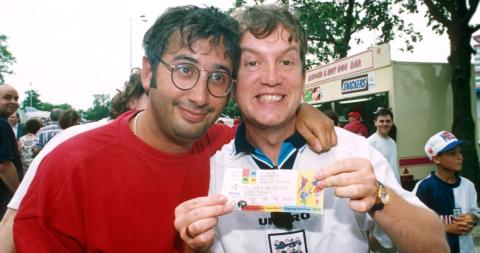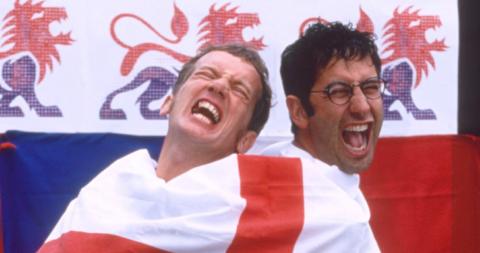Celebrating football anthem Three Lions: "It epitomised the giddy, euphoric spirit of the times"

This is an edited extract from When We Were Lions by Paul Rees, published by Aurum Press. www.quartoknows.com
Released on 17 May 1996, Three Lions, written and performed by Ian Broudie, Frank Skinner and David Baddiel, was commissioned by the FA for its official Euro 96 compilation album, The Beautiful Game. The album also featured contributions from the likes of Blur, Supergrass and Bristol trip-hop collective Massive Attack, but it was the wistful Three Lions that stood out. Evoking sepia-tinted memories of 1966 (‘Bobby belting the ball and Nobby dancing’), and mourning the ‘thirty years of hurt’ that had ensued for English football, it was certainly trite and twee, but ingratiating, too. It also had the additional bonus of an uplifting chorus. This was a single, oft-repeated line: ‘It’s coming home, it’s coming home, it’s coming, football’s coming home …’
Given free rein by the FA, the three composers agreed that the finished song should resonate with genuine football fans and reflect the highs and lows of following the national team. They surely accomplished that, but ultimately Three Lions tapped directly and more generally into the musical mood of the time. Broudie’s 1960s beat-pop-inflected tune and the song’s surging, optimistic refrain set it in the same Britpop line as such everyman anthems as Oasis’s Wonderwall, Blur’s Parklife and Common People by Pulp, and as such it was destined to find a much wider audience.
MORE: Check out Three Lions' full chart run here
Three Lions was completed by March and before England faced Bulgaria at Wembley that month, Broudie, Skinner and Baddiel were invited by the FA to preview their creation to Terry Venables and his squad at Bisham Abbey. "It was nerve-wracking," Skinner told the Independent. "We were having lunch with the players and, when we got to the cheesecake, Gazza couldn’t wait any longer and went to put the song on. Fortunately, he was unable to use a cassette player."

Image: Nils Jorgensen/REX
The composers were particularly anxious about how the song’s first verse would be received by its audience. Meant to establish the fatalistic mindset of England supporters, it ran: "Everyone seems to know the score, they’ve seen it all before. They just know, they’re so sure, that England’s gonna throw it away." According to Broudie, officials at the FA had blanched when hearing the song for the first time just days earlier and "hated it". There was also a dead-eyed response from the England players when it was played to them. "It was a funny moment," Broudie recalled to the Guardian in 2009. "As soon as those lines came on I was looking at the ghetto blaster and looking at them. I could see them thinking, 'What’s this guy saying? We’re going to get stuffed?'".
"At first, the players showed no more enthusiasm than occasionally tapping a fork against a plate," Baddiel added in the Independent. "Then we explained the song as if to a group of three-year-old children and they got it. Terry Venables was particularly positive about it. 'Roll on 8 June,' he said."
After lunch, the squad, along with Broudie, Skinner and Baddiel, headed out on to the training pitches, trailed by a film crew. Scenes of the players mouthing the words to the chorus of the song, and its writers joining them for a supposedly impromptu kick-about, were filmed for the video to accompany the track. The remaining scenes were shot on a chilly Saturday morning in late-April at a spit-and-sawdust pub, the Queen of the Isle in London’s Docklands. In these, the three performers were shown watching a compendium of England’s most enduring moments on the pub’s television set: Gordon Banks saving from Pele in the 1970 World Cup; Lineker scoring against the Germans in Turin; the toothless Nobby Stiles skipping across the Wembley turf with the Jules Rimet trophy. The punchline was the closing shot. As the three of them walked out of the pub, coming in the opposite direction was Geoff Hurst, England’s 1966 hat-trick hero.
Three Lions did not break the same ground as World in Motion and might not have been as good a song, but it had a big hook. Just as the England team flew in from Hong Kong, under siege, this began to sink in. 'Football’s coming home' resounded from car radios and pub jukeboxes up and down the country. A would-be anthem to both sing along and cry into a beer to, it also found an entirely receptive audience among a male stereotype who emerged in the mid-1990s: the Lad. An inverse reaction to the feisty feminism and caring, sharing 'new man' of earlier decades, being a Lad allowed British men an outlet to reclaim their maleness and revel once more in the simple pleasures of birds, beer and football.
Like the new man, the Lad was essentially a media construct, and as patronising a one at that, but it epitomised the giddy, euphoric spirit of the times. Upbeat and celebrating the communal experience, this ran counter to the grey, downtrodden image of Britain perpetrated by John Major and his government. It was turned loose at outdoor raves, found a voice in Liam Gallagher, and would soar to a crescendo at Wembley that June.
Two weeks after it was released, Three Lions climbed to number one in the charts. In doing so, it eclipsed the official theme tune of Euro 96, We’re In This Together, a flaccid effort from pop balladeers Simply Red. It gave a boost to Ian Broudie’s career. The Lightning Seeds’ next album, aptly named Dizzy Heights, was certified Gold soon after it was released the following November. The immediate rewards for Frank Skinner and David Baddiel were rather less glittering: both of them pocketed £35,000 apiece in royalties. Moreover, Three Lions served to wake the country up to England’s imminent quest for football glory and also helped encourage the nascent movement in the country back towards unashamed displays of patriotic symbolism.
Article image: Rex/Shutterstock
Join the conversation by joining the Official Charts community and dropping comment.
Already registered?
Log in
No account?
Register